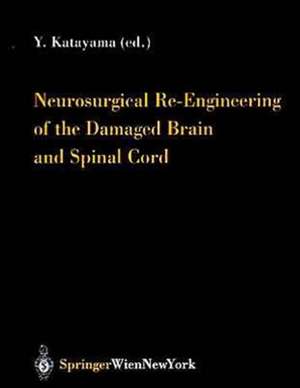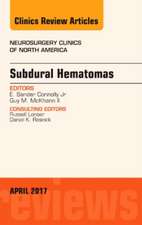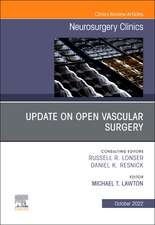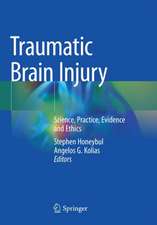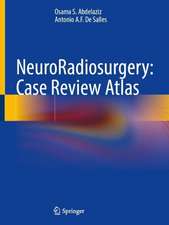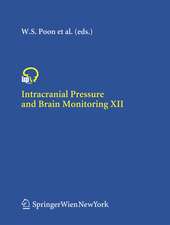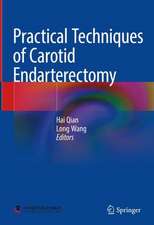Neurosurgical Re-Engineering of the Damaged Brain and Spinal Cord: Acta Neurochirurgica Supplement, cartea 87
Editat de Yoichi Katayamaen Limba Engleză Hardback – 28 aug 2003
Din seria Acta Neurochirurgica Supplement
- 5%
 Preț: 1798.83 lei
Preț: 1798.83 lei - 5%
 Preț: 1445.88 lei
Preț: 1445.88 lei - 5%
 Preț: 1102.31 lei
Preț: 1102.31 lei - 5%
 Preț: 1136.85 lei
Preț: 1136.85 lei - 5%
 Preț: 811.16 lei
Preț: 811.16 lei - 5%
 Preț: 1112.70 lei
Preț: 1112.70 lei - 5%
 Preț: 529.80 lei
Preț: 529.80 lei - 5%
 Preț: 791.25 lei
Preț: 791.25 lei - 5%
 Preț: 1303.26 lei
Preț: 1303.26 lei - 5%
 Preț: 410.88 lei
Preț: 410.88 lei - 5%
 Preț: 345.70 lei
Preț: 345.70 lei - 5%
 Preț: 1316.08 lei
Preț: 1316.08 lei - 5%
 Preț: 1452.28 lei
Preț: 1452.28 lei - 5%
 Preț: 1348.46 lei
Preț: 1348.46 lei - 5%
 Preț: 370.94 lei
Preț: 370.94 lei - 5%
 Preț: 376.22 lei
Preț: 376.22 lei - 5%
 Preț: 715.00 lei
Preț: 715.00 lei - 5%
 Preț: 364.17 lei
Preț: 364.17 lei - 5%
 Preț: 365.82 lei
Preț: 365.82 lei - 5%
 Preț: 366.91 lei
Preț: 366.91 lei - 5%
 Preț: 384.08 lei
Preț: 384.08 lei - 5%
 Preț: 397.16 lei
Preț: 397.16 lei - 5%
 Preț: 367.64 lei
Preț: 367.64 lei - 5%
 Preț: 373.12 lei
Preț: 373.12 lei - 5%
 Preț: 993.11 lei
Preț: 993.11 lei - 5%
 Preț: 394.07 lei
Preț: 394.07 lei - 5%
 Preț: 364.74 lei
Preț: 364.74 lei - 5%
 Preț: 1095.90 lei
Preț: 1095.90 lei - 5%
 Preț: 1824.06 lei
Preț: 1824.06 lei - 5%
 Preț: 1119.31 lei
Preț: 1119.31 lei - 5%
 Preț: 1312.09 lei
Preț: 1312.09 lei - 5%
 Preț: 1119.68 lei
Preț: 1119.68 lei - 5%
 Preț: 1331.76 lei
Preț: 1331.76 lei - 5%
 Preț: 1430.72 lei
Preț: 1430.72 lei - 5%
 Preț: 1405.49 lei
Preț: 1405.49 lei - 5%
 Preț: 1418.48 lei
Preț: 1418.48 lei - 5%
 Preț: 392.25 lei
Preț: 392.25 lei - 5%
 Preț: 1335.44 lei
Preț: 1335.44 lei - 5%
 Preț: 1375.20 lei
Preț: 1375.20 lei
Preț: 691.72 lei
Preț vechi: 728.12 lei
-5% Nou
Puncte Express: 1038
Preț estimativ în valută:
132.36€ • 138.19$ • 109.54£
132.36€ • 138.19$ • 109.54£
Carte tipărită la comandă
Livrare economică 31 martie-07 aprilie
Preluare comenzi: 021 569.72.76
Specificații
ISBN-13: 9783211009208
ISBN-10: 3211009205
Pagini: 196
Ilustrații: IX, 186 p. 45 illus.
Greutate: 0.77 kg
Ediția:2003
Editura: SPRINGER VIENNA
Colecția Springer
Seria Acta Neurochirurgica Supplement
Locul publicării:Vienna, Austria
ISBN-10: 3211009205
Pagini: 196
Ilustrații: IX, 186 p. 45 illus.
Greutate: 0.77 kg
Ediția:2003
Editura: SPRINGER VIENNA
Colecția Springer
Seria Acta Neurochirurgica Supplement
Locul publicării:Vienna, Austria
Public țintă
ResearchCuprins
Prolonged coma, minimally conscious state and persistent vegetative state.- Control of sleep and wakefulness by brainstem monoaminergic and cholinergic neurons.- Electrical treatment of coma via the median nerve.- Regaining consciousness for prolonged comatose patients with right median nerve stimulation.- DBS therapy for a persistent vegetative state: ten years follow-up results.- Clinical study on effect of HBO plus electric stimulation on treatment for the vegetative state.- Effects of musicokinetic therapy and spinal cord stimulation on patients in a persistent vegetative state.- Clinical application of the drug pump for spasticity, pain and restorative neurosurgery.- Intrathecal drug delivery 2002.- Clinical application of drug pump for spasticity, pain, and restorative neurosurgery: other clinical applications of intrathecal baclofen.- Intrathecal baclofen therapy; patient selection & team approach.- Current concepts and strategies of early neurorehabilitation.- New development of functional neurorehabilitation in neurosurgery.- Successful treatment by spinal cord stimulation for gait disturbance in a patient with diffuse axonal injury.- Functional electrical stimulation (FES) for spinal cord injury.- Functional imaging in neurosurgery and neurorehabilitation.- Bold functional MRI may overlook activation areas in the damaged brain.- Acetazolamide vasoreactivity in persistent vegetative state and vascular dementia evaluated by transcranial harmonic perfusion imaging and Doppler sonography.- Impairment of motor function after frontal lobe resection with preservation of the primary motor cortex.- Rehabilitation technique facilitates association cortices in hemiparetic patients: functional MRI study.- Neurosurgical intervention for functional recovery from neurological deficit: Part 1.- Early use of intrathecal baclofen in brain injury in pediatric patients.- Subtonsillar placement of auditory brainstem implant.- Diaphragm pacing with the spinal cord stimulator.- Neurosurgical intervention for functional recovery from neurological deficit: Part 2.- Combined dorsal root entry zone lesions and neural reconstruction for early rehabilitation of brachial plexus avulsion injury.- Functional posterior rhizotomy for severely disabled children with mixed type cerebral palsy.- The role of neurosurgical interventions for control of spasticity in neurorehabilitation: new findings on functional microanatomy of the tibial nerve.- Restoration of locomotion in paraplegics with aid of autologous bypass grafts for direct neurotisation of muscles by upper motor neurons — the future: surgery of the spinal cord?.- Neurosurgical treatment for movement disorders.- Brain stimulation: history, current clinical application, and future prospects.- Deep brain and motor cortex stimulation for post-stroke movement disorders and post-stroke pain.- Chronic simulation of the globus pallidus internus for control of primary generalized dystonia.- Neurosurgical treatment for writer’s cramp.- Neurophysiological identification and characterization of thalamic neurons with single unit recording in essential tremor patients.- Localization of thalamic cells with tremor-frequency activity in Parkinson’s disease and essential tremor.- MR safety in patients with implanted deep brain stimulation systems (DBS).- Pain control.- Primary motor cortex stimulation within the central sulcus for treating deafferentation pain.- Neurons with spontaneous high-frequency discharges in the central nervous system and chronic pain.- Nerve grafting and cell transplantation.- First humanventral mesencephalon and striatum cografting in a Parkinson patient.- Effect of subthalamic lesion with kainic acid on the neuronal activities of the basal ganglia of rat parkinsonian models with 6-hydroxydopamine.- Neural stem/progenitor cells survive and differentiate better in PD rats than in normal rats.- Mesencephalic progenitors can improve rotational behavior and reconstruct nigrostriatal pathway in PD rats.- Author Index.- Index of Keywords.
